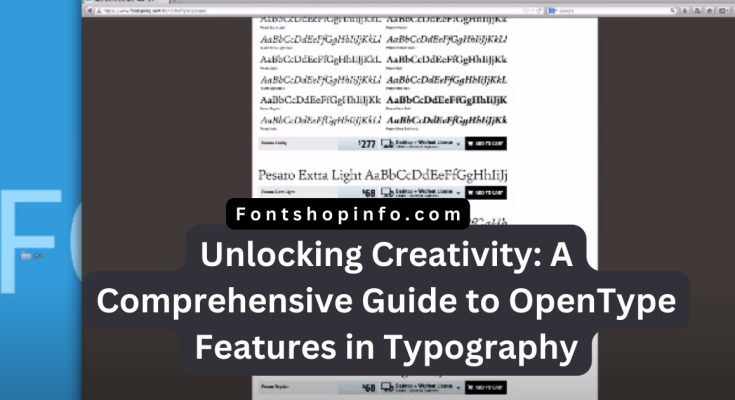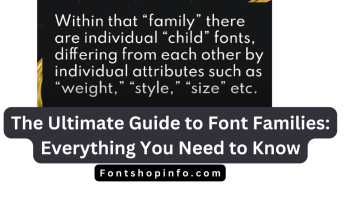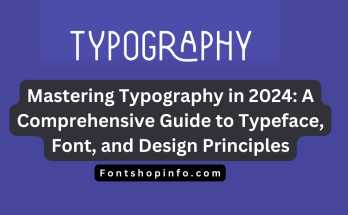OpenType Features
The art and practice of arranging type to make written language readable and aesthetically pleasing is known as typography.
In the field of typography, fonts are essential, and the utilization of OpenType features is one of the most exciting developments in font technology.
Check also Variable Fonts
We’ll go into the world of OpenType features in this article, examine their importance in graphic design, and discover the different components that go into creating readable and visually appealing fonts.
What is OpenType?
OpenType is a typeface format that extends the capabilities of conventional font formats like TrueType and PostScript to include sophisticated typographic features.
OpenType fonts, which were co-developed by Adobe and Microsoft, have a large character set that makes them adaptable to a wide range of languages and design applications.
Improved typographic control made possible by the OpenType format enables designers to produce text that is more dynamic and aesthetically pleasing.
Understanding Typography
Let us first understand some fundamental typographic concepts before exploring OpenType features. In typography, characters and letters are arranged and designed to convey a message.
Character styles or sets with a common design are called fonts. The term “typeface” describes the particular layout of a character set, like Times New Roman or Arial.
Typography is a visual art form in addition to being a means of making words readable. A document’s or design’s overall appearance and feel can be affected by the arrangement and shape of the letters.
Key Components of OpenType Features:
Glyph Substitution
Glyph substitution is one of OpenType’s core functions. A glyph is a particular type of character, and substitution is the process of automatically swapping out one glyph for another to make the text look better overall. Better character alignment and spacing are made possible by this feature.
Ligatures
Ligatures are character combinations consisting of two or more that are intended to flow together more aesthetically. Ligatures are frequently used in OpenType fonts to improve the visual appeal of specific character combinations, like “fi” or “fl.”
Kerning
Kerning is the process of modifying the distance between individual characters to produce a text that is aesthetically pleasing and harmonious. Improved kerning options from OpenType fonts can guarantee that characters align perfectly.
Small Caps
Uppercase letters that are intended to be the same height as lowercase letters are called small caps. In some situations, OpenType fonts offer small caps as an option for a more sophisticated and unified look.
Swashes
Characters can have flourished, ornamental elements added to them, called sweeps, usually at the start or finish of a word. Designers can add swashes to their designs to add a refined and fashionable touch, thanks to OpenType features.
Stylistic Alternates
Alternative character designs known as stylistic alternates give a particular letter a different look. This feature enables designers to select different forms for a more unique and imaginative appearance.
Contextual Alternates
Alternate character forms known as contextual alternates alter according to the characters surrounding them. This feature improves the text’s overall coherence and aesthetic appeal across a range of situations.
Character Variants
Different character variants may be included in OpenType fonts, giving designers the option to select distinct styles for individual characters. This adaptability fosters typographic creativity.
Numerical Styling
Numerous numeral formats, including lining figures, old-style figures, tabular figures, and proportional figures, are available with OpenType’s numerical styling features. Because of their adaptability, numbers can be used in a wide range of design contexts.
Fractions
Fraction glyphs are available in OpenType fonts, allowing designers to express fractions in a visually consistent and aesthetically beautiful way.
Using OpenType Features in Design
Now that we have a rudimentary understanding of OpenType features, let’s investigate the potential applications of these elements in graphic design.
Let’s say you are designing a poster for a school function. You can give the event title a little flair by selecting an OpenType font with ligatures and swashes. Swashes could gracefully flow from the initial and final letter, and ligatures could improve the relationship between specific character pairs.
You could use an OpenType font with stylistic alternates and small caps for the poster’s body. Using stylistic alternates to add subtle variations to individual letters and small caps to maintain a consistent visual weight throughout the text can enhance the overall design.
Including OpenType features improves readability and effectively communicates the intended message in addition to being aesthetically pleasing.
Conclusion
The intriguing fusion of functionality and art that is typography has given designers new avenues to express their creativity thanks to OpenType features.
Knowing the features of OpenType can enhance your design abilities, regardless of whether you’re a student learning about fonts or an enthusiast for graphic design.
FAQ
What is OpenType?
Microsoft and Adobe created the OpenType font format, which offers more sophisticated typographic features than other font formats. It gives designers more control and supports a large variety of characters.
How does OpenType improve typography?
With features like glyph substitution, ligatures, kerning, small caps, swashes, and more, OpenType enhances typography. These characteristics improve the text’s readability and aesthetic appeal in design projects.
What are glyphs?
In a font, glyphs are particular character variants. Glyph substitution is a feature of OpenType that automatically switches out one glyph for another to improve alignment and spacing.
What are ligatures, and why are they important?
Ligatures are character combinations consisting of two or more that are intended to flow together. They complement some character pairs, such as ‘fi’ and ‘fl,’ making the text look better overall.
How does kerning impact typography?
Kerning is the process of changing the distance between individual characters to create a text that is more aesthetically pleasing and harmonic. Better kerning options are available with OpenType fonts.
What are small caps in OpenType fonts?
Small caps are capital letters made to resemble lowercase letters in height. In certain situations, OpenType fonts may have small caps for a polished and unified appearance.
What role do swashes play in typography?
Swashes are adornment elements that are added to characters; they are usually seen at the start or finish of a word. Designers are able to add swashes for style and elegance thanks to OpenType features.
What are stylistic alternates in OpenType fonts?
Stylistic alternates are different character designs that give a particular letter a different appearance. For a look that is more imaginative, designers can select different forms.
How do contextual alternates work in OpenType?
Alternate character forms known as contextual alternates shift in appearance depending on the characters surrounding them. This feature improves the text’s overall coherence and aesthetic appeal across a range of situations.
What are character variants in OpenType fonts?
Different character variants may be included in OpenType fonts, giving designers the option to select distinct styles for particular characters. This adaptability fosters typographic creativity.
How do OpenType fonts handle numerical styling?
Additional OpenType features include numerical styling, offering choices for various numeral formats, including proportional, tabular, old style, and lining figures.
Why are fractions included in OpenType fonts?
Fraction glyphs are available in OpenType fonts, enabling designers to depict fractions in a logical and aesthetically beautiful way.
How can OpenType features be used in graphic design?
OpenType features allow designers to improve a project’s visual appeal. Adding swashes, ligatures, and other features to posters and school assignments enhances their creativity and readability.
Can OpenType features be used by beginners?
Yes, even beginners can use OpenType features. Design projects can gain depth and originality by experimenting with OpenType features and learning the fundamentals of typography.
Where can I find OpenType fonts?
Design software and font libraries make OpenType fonts widely accessible online. There are several websites that provide both paid and free ways to download OpenType fonts.
Are OpenType features only for professional designers?
No, anyone with an interest in typography and design is free to use OpenType features. For both novices and experienced designers, they offer an adaptable toolkit to improve their work.
Can I use OpenType features in word processing software?
OpenType features are supported by a lot of word-processing programs. These tools are available to users to help them with their document typography.
How do I learn more about OpenType features?
Check out the resources offered by font foundries, design courses, and online tutorials to discover more about OpenType features. To obtain practical experience, practice experimenting with various features.
Are OpenType features supported on all devices?
Certainly, a wide range of hardware and operating systems support OpenType features. The majority of contemporary design programs and software are aware of and make use of OpenType features.
What’s the importance of OpenType in modern design?
OpenType is crucial to contemporary design because it gives designers a wide range of tools to produce dynamic and aesthetically pleasing typography. In a variety of design tasks, it promotes artistic expression and enhances readability.



